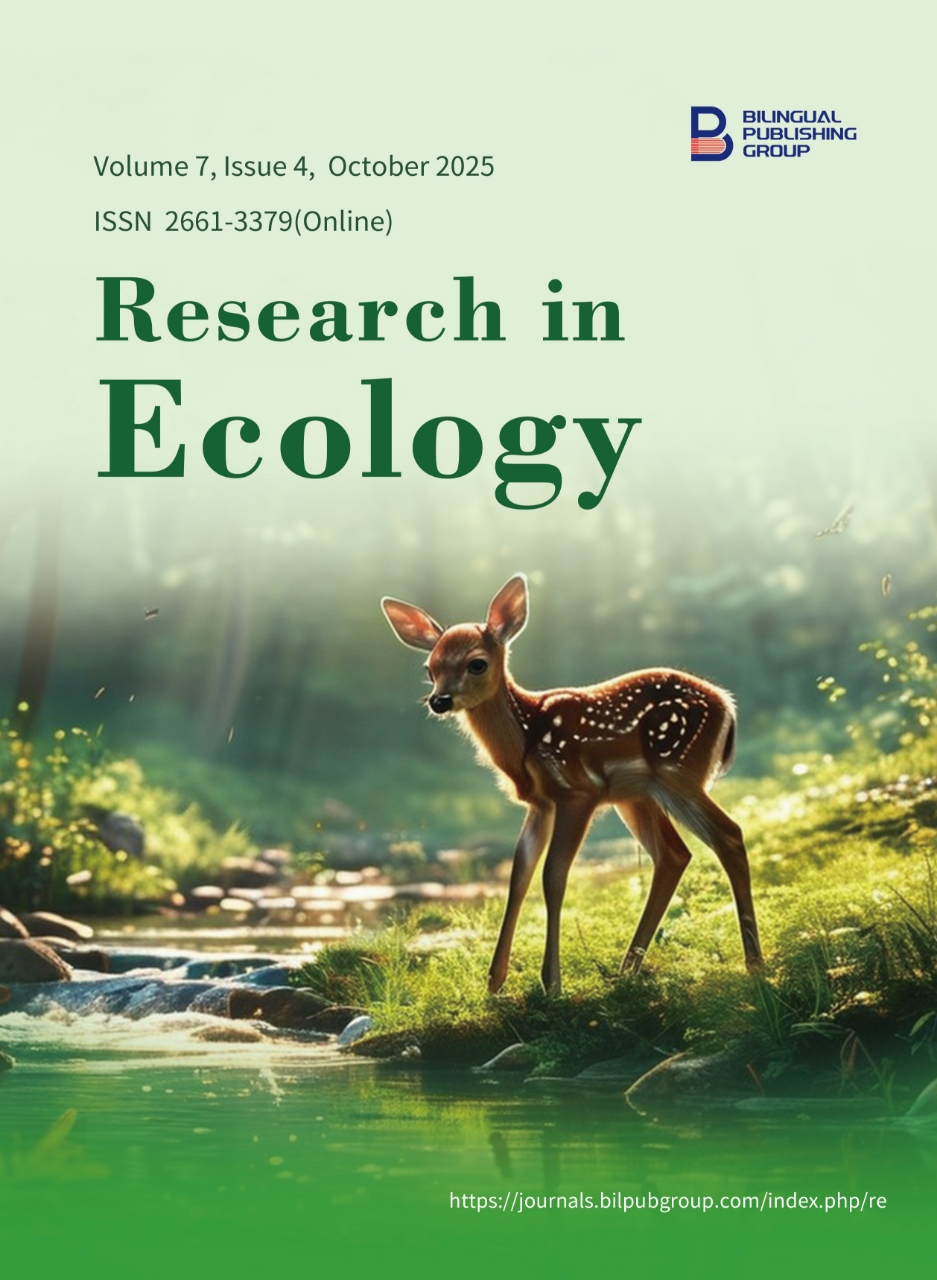
Bio-Damaging Bird and Mammal Species in Urban Landscapes of Kyrgyzstan: Damage and Mitigation Measures (Osh City Case Study)
DOI:
https://doi.org/10.30564/re.v7i4.9815Abstract
Under conditions of increasing urbanization, the problem of studying the impact of synanthropic animal species on the functioning of urban ecosystems is becoming increasingly important. The purpose of this study was to identify and analyze the species composition of synanthropic birds and mammals in the urban area of Osh (Kyrgyzstan), assess the degree of their bio-damaging activity, and develop recommendations to minimize their negative impact on various sectors of the urban environment. Field studies conducted in 2023–2024 revealed 22 species of synanthropic birds and 7 species of synanthropic mammals. Among birds, representatives of Columbiformes (3 species), Apodiformes (2 species), and Passeriformes (18 species) were identified, including families Hirundinidae, Motacillidae, Sturnidae, Corvidae, Turdidae, Paridae, Passeridae, Fringillidae, and Emberizidae. All recorded mammal species belonged to Rodentia, represented by the families Gliridae, Cricetidae, Gerbillidae, and Muridae. Most of these species are closely related to human activities, including obligate and facultative synanthropes (23 species) successfully adapted to anthropogenic landscapes. There are also pseudosynanthropes (6 species) that occur in populated areas but are not directly dependent on humans. The analysis showed that synanthropic species cause considerable damage to urban agriculture, infrastructure, and utilities. Major impacts include crop destruction, deterioration of monuments, damage to networks, and disease transmission. Special attention was paid to Meriones libycus, Ellobius tancrei, and Dryomys nitedula, recently identified as synanthropic species in Kyrgyz cities. Their inclusion provides new insights into urban ecosystem dynamics. The study proposes integrated control measures, including mechanical, chemical, and biological methods for effective management of bio-damaging species.
Keywords:
Synanthropic Species; Bio-damaging Species; Rodents; Urbanized Landscape; Degree of Synanthropy; Obligate Synanthropy; Facultative Synanthropy; Pseudo-synanthropy; Degrees Of Bio-damageReferences
[1] Bykova, E.A., 2017. Influence of urbanization on the fauna and ecology of mammals of Uzbekistan: on the example of Tashkent city [PhD Thesis]. Tyumen State University: Tyumen, Russia. pp. 1–19.
[2] Aidaraliev, E.K., Abdykaarov, A.M., 2024. Synanthropization of the forest dormouse (Dryomys nitedula Pallas, 1799) in the floodplain of the Ak-Buura River. Bulletin of Osh State University. Chemistry. Biology. Geography. 1(4), 33–38. DOI: https://doi.org/10.52754/16948688_2024_1(4)_5
[3] Abdykaarov, A.M., 2005. Birds of the city of Osh and its environs [PhD Thesis]. Osh State University: Osh, Kyrgyzstan. pp. 1–25.
[4] Abdykaarov, A.M., Stamaliev, K.Y., 2001. Birds as bioindicators of the ecological state of the city of Osh and its environs. In Proceedings of the International Scientific Conference. Osh State University: Osh, Kyrgyzstan. pp. 71–78.
[5] Abdykaarov, A.M., Matkerimova, F.K., Kudaynazarova, N.M., 2022. Fauna of synanthropic bird species of Osh city. Science, New Technologies and Innovations of Kyrgyzstan. 1, 41–44.
[6] Stamaliev, K.Y., 2014. Passeriform birds (Passeriformes) in urbanized landscapes in the south of Kyrgyzstan [PhD Thesis]. Osh State University: Osh, Kyrgyzstan. pp. 1–26.
[7] Stamaliev, K.Y., Abzhamilov, S.T., Abdykaarov, A.M., 2014. Passeriform birds inhabiting the biotopes of urban ecosystems in one and two-storey dwellings. Izvestiya Vuzov (Kyrgyzstan). 7, 46–49.
[8] Kendirbaeva, S.K., 2007. Birds of wetlands of the Issyk-Kul Basin [PhD Thesis]. Osh Technological University: Osh, Kyrgyzstan. pp. 1–26. Available from: https://rusneb.ru/catalog/000200_000018_RU_NLR_bibl_1116946/?utm_source=chatgpt.com
[9] Zhusupbaeva, A.A., 2013. Birds of Bishkek city (abundance, spatial and temporal structure and organization) [PhD Thesis]. Kyrgyz National University named after Zhusup Balasagyn: Bishkek, Kyrgyzstan. pp. 1–24.
[10] Alymkulova, A.A., 2020. Ecological and biological assessment of the introduction of alien rodent species in Central Asia (on the example of Rattus norvegicus Berkenhout, 1769) [PhD Thesis]. Institute of Biology of the Academy of Sciences of the Kyrgyz Republic: Bishkek, Kyrgyzstan. pp. 1–42.
[11] Atabekov, U.A., 2013. Fauna of rodents of Southern Kyrgyzstan [PhD Thesis]. Bishkek, Kyrgyzstan. pp. 1–24.
[12] Lafia N'gobi, G.M., Danani, K., Soulé, M., 2022. Climate change and biodiversity in West Africa Sahel: A review. Research in Ecology. 4(3), 20–29. DOI: https://doi.org/10.30564/re.v4i3.4961
[13] Stamaliev, K.Y., Abdykaarov, A.M., Kulbaev, A., et al., 2024. Impact of climate change on the fauna of passerines (Passeriformes) in urbanized ecosystems of southern Kyrgyzstan. E3S Web of Conferences. 537, 05020. DOI: https://doi.org/10.1051/e3sconf/202453705020
[14] Wolpert, J.L., 2013. Mammals in the anthropogenic landscape. International Journal of Applied and Fundamental Research. 8(1), 31–33. Available from: https://applied-research.ru/ru/article/view?id=3838
[15] Barotov, A., Tursunov, O., Shodieva, F., Kholboev, F., 2024. Ecology and significance of synanthropic species in the desert zone of Uzbekistan (as an example of birds and mammals). International Journal of Genetic Engineering. 12(1), 1–4. Available from: http://article.sapub.org/10.5923.j.ijge.20241201.01.html
[16] Demirarslan, K.O., Yener, I., 2021. Municipal solid waste in Turkey and its relationship with the population. Research in Ecology. 3(1), 31–40. DOI: https://doi.org/10.30564/re.v3i1.2895
[17] Garcês, A., Pires, I., 2024. The detrimental impacts of plastic pollution on wildlife. Research in Ecology. 6(2), 42–46. DOI: https://doi.org/10.30564/re.v6i2.6294
[18] Savard, J.-P.L., Clergeau, P., Mennechez, G., 2000. Biodiversity concepts and urban ecosystems. Landscape and Urban Planning. 48(3–4), 131–142. DOI: https://doi.org/10.1016/S0169-2046(00)00037-2
[19] Elizarov, V.V., Elizarova, A.V., Surinsky, D.O., 2016. Negative impact of synanthropic birds on AIC and methods of their control. Young Scientist. 27(131), 70–73. Available from: https://moluch.ru/archive/131/36493/
[20] Davis, S., Guerreiro Milheiras, S., Olivier, P.L., et al., 2024. Cropland can support high bird diversity in heterogeneous rural tropical landscapes. Bird Conservation International. 34, e13, 1–10. DOI: https://doi.org/10.1017/S0959270924000030
[21] Dorzhiev, T.Z., Saaya, A.T., Gulgenov, S.J., 2020. Synanthropic nesting birds of steppe landscapes of Tuva and Buryatia. Baikal Zoological Journal. 2(28), 33–48.
[22] Kucheruk, V.V., 1986. Quantitative accounting of the most important species of rodents and shrews. Mir: Moscow, Russia. pp. 1–376.
[23] Timoshkina, O.A., 2012. Methods of field studies of small mammals. Krasnoyarsk State Agrarian University: Krasnoyarsk, Russia. pp. 1–20.
[24] Cadastre of the Genetic Fund of Kyrgyzstan, 2015. Volume IV. Type Chordata – chordates. Bishkek, Kyrgyzstan. pp. 1–128.
[25] National Academy of Sciences of the Kyrgyz Republic, Institute of Biology, 2010. Systematic List of Vertebrate Animals of Kyrgyzstan. Institute of Biology, National Academy of Sciences of the Kyrgyz Republic: Bishkek, Kyrgyzstan. pp. 1–116.
[26] Stamaliev, K.Y., 2014. Synanthropic birds of urbanized ecosystems of southern Kyrgyzstan. Fundamental Research. 11(5), 1081–1085.
[27] Reshenkin, A.S., Psardieva, N.N., 2021. Methods and means of bird deterrence in the conditions of aircraft takeoff and landing. Young Researcher Don. 1(28), 68–72. Available from: https://cyberleninka.ru/article/n/metody-i-sredstva-otpugivaniya-ptits-v-usloviyah-vzleta-i-posadki-samoletov
[28] Koricho, H.H., Song, S., 2021. Assessment of urban greenery status in major cities of Oromia, Ethiopia. Research in Ecology. 3(3), 21–27. DOI: https://doi.org/10.30564/re.v3i3.3638
Downloads
How to Cite
Issue
Article Type
License
Copyright © 2025 Abdimannap Abdykaarov, Kutmanaly Stamaliev, Gulbaira Tolokova, Bakhtiyor Sheraliev

This is an open access article under the Creative Commons Attribution-NonCommercial 4.0 International (CC BY-NC 4.0) License.




 Abdimannap Abdykaarov
Abdimannap Abdykaarov






